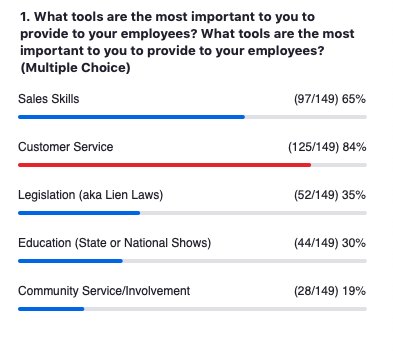Menu
Sign in below to keep watching.
From the costs to customer expectations, running a facility focused on storing boats, RVs, and other vehicles is very different from running a traditional self storage facility full of storage units. There's a lot to know to set yourself up for success. Whether you're new to storage entirely or you're a seasoned storage veteran trying to add vehicle storage to your portfolio, this Gabfocus session features experts and veterans in the field that can give you the perspective you need!
Featured Speakers: Terry Anderson, Barry Raber & Greg Ellsworth
Moderators: Tommy Nguyen & Melissa Huff
Category: Boat & RV Storage
Focus: Owners & Operators
Aired: September 29, 2022
Duration: 1:08:51
If you don't have time to watch the whole session, here are some of our favorite parts:
We asked our experts: What are the most common myths in recreational vehicle storage?
One thing that I found interesting is that the % of vehicles that are trailers and towables is super high. So you think RV, which to me is a vehicle with an engine. But from August—August sales numbers from the industry, 82% of sales in the industry are towables." - Barry Raber
"The myth is that the economy is going to slow it all down. It's not. I'm telling you were on a run in the next ten to fifteen years with this new asset class." - Terry Anderson
"Your delinquency rate on boat and RV storage is less than it would be on a traditional storage site. The myth is that when a tenant goes deliquent they're able to just pick up and leave. You're dealing with a different type of tenant in boat and RV storage, and those tenants are typically a little bit more affluent and so they do not go deliquent on their units nearly as often." - Greg Ellsworth
There are similarities between self storage and boat & RV storage. This can help you bridge the gap when trying to transition from one to the other. When it comes down to it, though, the key difference between the two industries is the customer and the reason they're looking for storage. Pay attention to your intended market and the amenities they want to make sure you build a strong reputation for word-of-mouth marketing!
Gabfocus Sessions are virtual workshops for self storage owners, managers, and operators. Brought to you by the team behind Gabfest: StoragePug and Affordable Storage Guys Management.
Each session features hand-picked industry pros who will dive deep into relevant topics surrounding our industry, share best practices, and explore trends in the market. It's our hope that these sessions help you navigate your self storage business better during these uncertain times.
Want to learn more about self storage? Join us on select Thursdays for Gabfocus.




Our panelists will be happy to answer any questions you have. We hope you enjoyed this Gabfest Session. Talk soon!
“Once your operation is in place, you can become more dynamic with your pricing, but that requires data. You need some method of being able to record the data that you need to know whether your price is in the right place - whether you need to move it up or start giving some concessions.” - Warren Lieberman
“I never want to downplay to what someone else is doing. I'm better than they are, then I'm going to be worth a higher price. That's what value is. If you go out to a restaurant and get really good service, would you go back? Yes! What if it was pricier? You'd still go back because you got better service and a better product.” - Jim Mooney
"It's good to be informed on your competition. I don't want to ignore them, but I don't want to respond too strongly to them either." - Warren Lieberman
"We did a survey of 10,000 facilities on their pricing. We found out that two-thirds of those operators didn't change the price of a single unit of the course of a month." - Warren Lieberman
“Rate increases and value pricing are the number one ways to grow your revenue.” - Jim Mooney
"Tenants in more convenient units tend to be less price sensitive." - Warren Lieberman
"The size of the unit is only one aspect of what people are willing to pay for." - Warren Lieberman
Lease up marketing strategies:
Your average customer value
Find the average stay length of all tenants. Next take your economic occupancy and divide by how many units you have. That will tell you what the average customer pays.
Multiply the average length of stay by what the average customer pays, and that's the average value of a customer.
For example, if a customer stays for 12 months and pays $100 per month, then their value is $1,200.
Your average lead value
Figure out your closing rate (or conversion rate) i.e. how many leads do you turn into tenants? Multiply that by your average customer lifetime value to figure out what your leads are worth.
Pro Tip: see which lead sources are converting the best. It may be that certain sources have a higher conversion rate, so those leads are worth more to you than a source that barely converts.
Typical Lease-up timeline
According to our panelists, it's typical to see a 3-4% increase each month, putting your facility at 36% after the first year, and 72% after the second.
Alternately, you can look at your lease up goals through the lens of your units, aiming for 20 units rented per month.
For Nick and StorageMax, they pro forma their economic occupancy at 85% with their sweet spot at 92%.